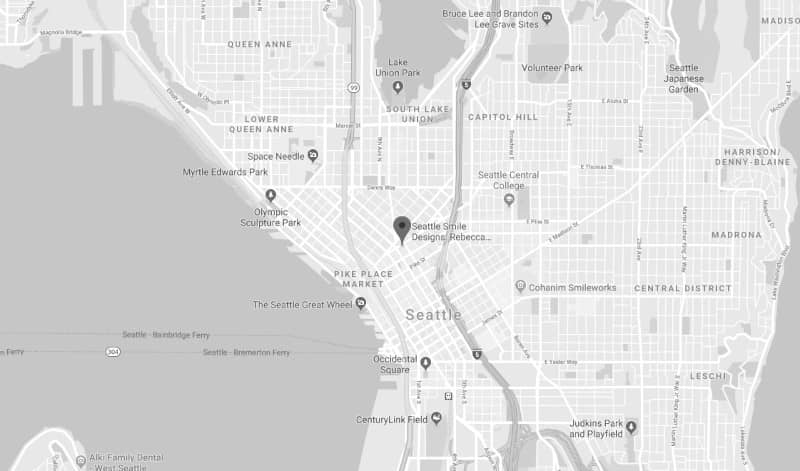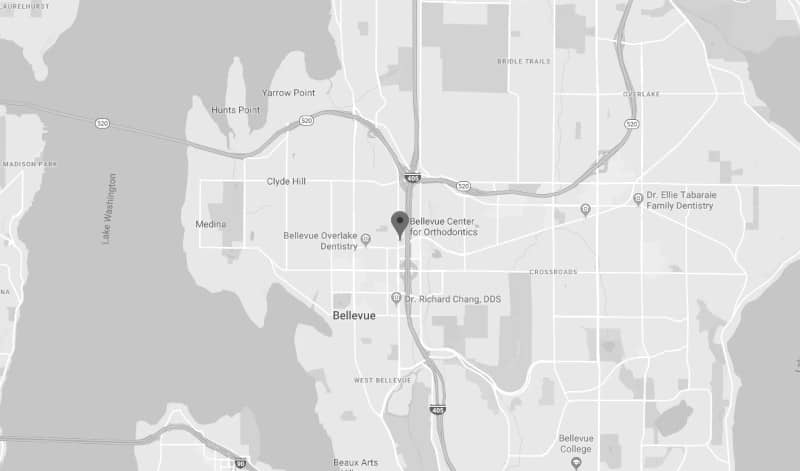Formerly Seattle Smile Designs & Bellevue Center for Orthodontics
Refer a PatientPatient Care
A Better
Smile
Oral Hygiene
How to care for your mouth while undergoing orthodontic treatment.
Great oral hygiene is key to overall oral health. When an appliance is glued to the teeth, this makes it more challenging and time consuming to care for your teeth. Please be mindful of this and spend extra time brushing and flossing while undergoing orthodontic care.
Caring for your teeth and gums
Food that is not cleaned off of your teeth leads to plaque and bacterial build-up on and around your teeth and your appliances. Braces, the wires, and the elastic ties around the brackets all act to trap bacteria and present challenges when cleaning your teeth. Appliances cemented on your teeth will only protect the surfaces they cover, but all areas around the appliance need to be cleaned regularly. Invisalign and other aligners can trap bacteria, making it important to clean your teeth before putting your trays back in after meals. Inadequate home care can lead to increased incidences of white spot lesions (white scars) on the teeth, cavities, and gum and bone disease.
Keeping plaque under control is the best way to preserve healthy gums and teeth. The three ways to preserve oral health are: diet, daily home care, and regular professional cleanings.
Diet and oral health
Diet and sugars are the cause of tooth decay. Cutting down or eliminating foods and beverages with excess sugar – including sodas and juice, sweets and ice cream – will help reduce the incidences of cavities. It is also important to avoid sticky sweet foods that can not only break brackets and appliances, but also get caught under the wire and next to your teeth and lead to cavities.
Acid in beverages like soda and citrus juices is twice as harmful to your teeth. The acidity erodes the enamel and the sugar then washes over the eroded enamel, setting the stage for increased tooth decay and enamel loss.
Daily Maintenance & Home Care
Appliances
(expanders, lip bumpers, lingual arches, etc)
Clean around the appliances with a normal toothbrush. Be sure to brush along the gum line. Waterpiks are very helpful when it comes to getting food out from underneath and around an expander.
Braces
Soft-bristle and small-head tooth brushes are great at getting both above and below the wire. It is important to clean around the brackets and wires in all directions. Waterpiks, interproximal or “proxabrushes” and interdental brushes are all great tools for getting food out that has been stuck around the brackets under the wire. Floss threaders and superfloss both help get floss under the wire so you can comfortably floss your teeth.
Caring for your teeth and aligners while in Invisalign
When undergoing orthodontics with clear aligners, it is important to keep your teeth clean. Placing a tray on dirty teeth will only hold the bugs on your teeth – making you more prone to develop cavities. It is important to keep your teeth very clean while using Invisalign. We suggest brushing after each meal whenever possible before putting your aligners back in.
Keep your aligners looking clean and fresh by avoiding colored foods and colored liquids while wearing the trays. Feel free to try any or all of the following to keep your trays clean:
- Use dish soap to clean the trays – it will keep them sparkling.
- Drop the trays in denture cleaner while eating dinner.
- Clean the aligner with your toothbrush.
- Purchase and use “retainer brite” online.
- Avoid dropping the trays in alcohol-based mouth rinses – it will make the material appear foggy.
- Do not drop them in hot water as it may cause the trays to distort.
Professional Care *
It is important that you see your dentist and hygienist at least 2 times a year. While undergoing orthodontics, it is often best if you see your dentist and/or periodontist 3 or 4 times a year due to the added plaque and tartar buildup that we often see with orthodontic patients. Your dentist is not only looking at how great your teeth are straightening out, he or she is also looking for cavities, gum health and bone health. These visits are very important for the overall health and longevity of your teeth.
*Please let us know ahead of time if you would like your wires out prior to your cleaning. We will try to schedule your regular adjustment appointment the same day as your cleaning. We will take the wires out prior to your cleaning, and complete your adjustment when you return after your cleaning.

Emergency Orthodontic Care
---True orthodontic emergencies are rare, but when they occur we are available to you. As a general rule, you should call our office when you experience severe pain or have a painful appliance problem you cannot take care of yourself. We will be able to schedule an appointment to resolve the problem.
You might be surprised to learn that you may be able to solve many problems yourself temporarily until you can get to our office. If there is a loose piece that you can remove, put it in a plastic bag or envelope and bring it with you to your next appointment. If your braces are poking you, put soft wax on the piece that’s sticking out. If the wire has slid to one side, you can pull it back to the other side with needle-nosed pliers, replacing it in the tube on the back tooth.
After alleviating your discomfort, it is very important that you still call our office as soon as possible to schedule a time to repair the problem. Allowing your appliance to remain damaged for an extended period of time may result in disruptions to your treatment plan.
Call Our OfficeGeneral Soreness
When you get your braces on, you may feel general soreness in your mouth, and teeth may be tender to biting pressures for three to five days. Stick to a soft diet until your teeth do not hurt to chew. Irritated gums and other sore spots can be relieved by rinsing your mouth with a warm salt-water mouthwash. Dissolve one teaspoonful of salt in eight ounces of warm water, and rinse your mouth vigorously. If the tenderness is severe, take Acetaminophen (Tylenol) or whatever you normally take for headache or similar pain. Aspirin, Ibuprofen (Motrin, Advil) and Naproxen Sodium (Naprosyn, Anaprox) actually slow the tooth movement, so it is not advisable to use them frequently while wearing braces.
The lips, cheeks, and tongue may become irritated for one to two weeks as they learn a new posture and become accustomed to the surface of the braces. You can put wax on the braces to lessen this. You can also use soft silicone, similar to the material swimmers use to plug their ears, roll it into a ball and place it on the bracket or wire where you feel an irritation.
Extra-Oral Appliances (Headgear, etc)
Sometimes discomfort is caused by not wearing your headgear or appliance as instructed by your orthodontist. Please refer to the instructions provided by your orthodontist. If the facebow (metal piece) is bent, please call our office for assistance. The headgear should hurt less the more it is worn, so be sure you get in the prescribed number of hours.
Loose Appliance
If your appliance is poking you, place wax on the offending part.
Loose Bracket
If your bracket or band is still attached to the wire, please leave it in place and put wax on it if needed for comfort. If the bracket or band can be removed easily, place it in an envelope and save it to bring to your next appointment.
Loose Wire
Using a pair of tweezers or needle-nosed pliers, try to put your wire back into place. It is okay to use a piece of floss to tie the wire into place: tie the floss around the bracket in place of the missing colored o-ring. If you cannot put the wire into a comfortable position, and covering the end with wax doesn’t help, as a last resort use a small fingernail clipper to clip the wire behind the last tooth to which it is securely fastened. If the end of the wire is still sharp place wax on it.
Poking Wire
Using a pencil eraser, push the poking wire down or place wax on it so that it is no longer poking.
Foods
To
Avoid
During Orthodontic Treatment
While you are wearing braces, please avoid eating hard foods, sticky foods and foods high in sugar.
Hard foods can break or damage the wires and brackets, and sticky foods can get caught between the wires and brackets. Minimize the amount of sugary foods you eat; the sugar can cause tooth decay and other related problems.
Candy
- Gum (sugar-free or regular)
- Licorice
- Sugar Daddies
- Toffee
- Tootsie Rolls
- Caramels
- Starburst
- Jolly Ranchers
Hard Foods
- Ice
- Nuts
- Hard taco shells
- French bread crust/rolls
- Corn on the cob
- Uncooked Apples or Carrots (unless cut into small pieces)
- Bagels
- Chips
- Pizza crust
Sugary Drinks
- Soda
- Sweetened tea
- Gatorade
- Kool-Aid
- Drinks with sugar
It is important to regularly check your braces for bent or loose wires and brackets.
A bracket moving along the wire means it has come unglued from the tooth. If you find a loose/broken wire or bracket, please call our office immediately. We will do our best to fit you in as soon as we can. Please bring any and all broken pieces like brackets and bands to your appointment.
Our goal is a beautiful smile at two locations

Seattle Orthodontics
---509 Olive Way Suite 840
Seattle, WA 98101
Text or Call: (206) 623-2192 | Email
Office Hours
Mon - Wed, 8:00 AM - 4:30 PM
Thu, 9:00 AM - 12:00 PM

Bellevue Orthodontics
---1200 112th Ave NE B-200
Bellevue, WA 98004
Text or Call: (425) 453-0551 | Email
Office Hours
Mon - Thurs, 8:00 AM - 4:30 PM
Fri, 9:00 AM - 4:30 PM